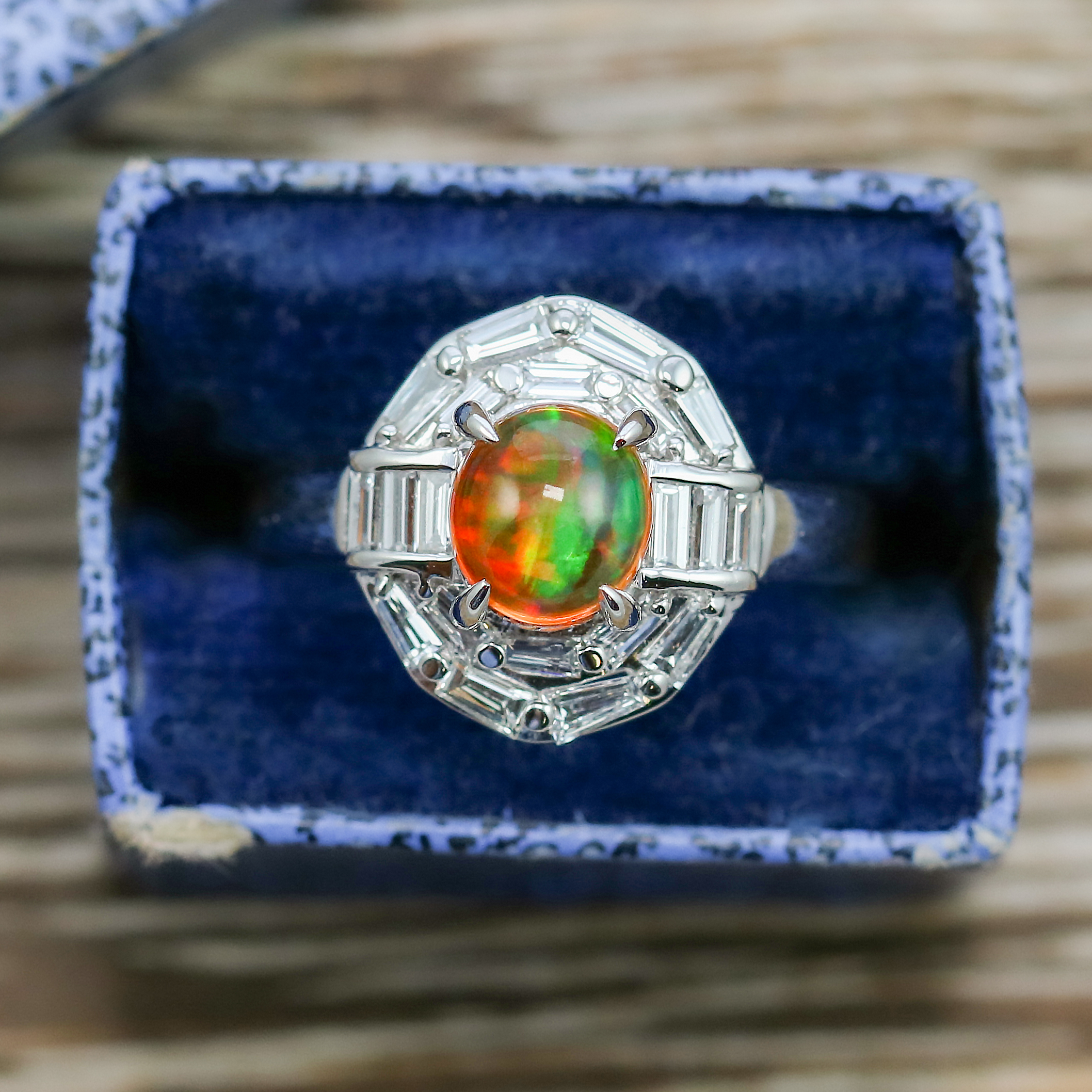Courtesy Levy’s Fine Jewelry
In a luxury landscape where “sustainability” has no single legal or universal definition, younger buyers are creating their own. For Millennials and Gen Z, sustainability often means extending the life cycle of existing goods, purchasing pre-owned pieces rather than commissioning new ones. In jewelry, this ethos is fueling a rising global demand for antique and vintage designs, where heritage craftsmanship aligns with a desire for a lighter environmental footprint.
A clearer path in an ambiguous sustainability landscape
The jewelry sector, like the broader luxury market, operates in a gray area when it comes to environmental claims. Regulatory frameworks such as the U.S. Federal Trade Commission’s Green Guides still leave significant room for interpretation. In this vacuum, younger consumers are turning toward goods with transparent origins and measurable impact reduction. Antique and vintage jewelry inherently sidesteps the environmental toll of new mining, manufacturing and large-scale production, offering a tangible alternative to consumers wary of greenwashing.
As jewelry designer Elaine Chong of Elaine Chong Designs points out, “One misconception is that buying antique jewelry is risky. But if you do your due diligence and buy from a reputable seller, it’s a safe and rewarding investment. I always encourage clients to research and ask questions; that confidence benefits everyone.”
The market’s momentum is supported by broader luxury trends. The personal luxury goods sector, which includes jewelry, fashion, leather goods and watches, expanded at a compound annual growth rate (CAGR) of five percent from 2019 to 2023, according to The State of Fashion: Luxury 2025 by the Business of Fashion and McKinsey & Company—growth often fueled by price hikes rather than volume. As the industry enters a slower growth phase (projected between one and three percent annually between 2024 and 2025), categories with enduring desirability and sustainable positioning, such as jewelry, are expected to outperform. Analysts expect luxury jewelry sales to grow by four to six percent annually between 2025 and 2027, driven in part by a younger, more diverse client base.

Courtesy Parkin & Gerrish, Photo by Freddie Ardley
Defining the market: antique, vintage and estate
In global trade, clear terminology matters. “Antique” jewelry is generally defined as over 100 years old, “vintage” as 20 to 99 years old and “estate” as any pre-owned piece, regardless of age. These distinctions influence not only appraisal values but also the storytelling potential that drives emotional connection. For a generation seeking goods that carry both beauty and history, these definitions provide a framework for authenticity in a market saturated with mass production.
Generational values meet heritage craftsmanship
Millennials and Gen Z approach luxury differently from their predecessors. While previous generations often associated luxury with brand prestige and newness, today’s younger buyers seek individual expression, ethical sourcing and lasting quality. Antique and vintage jewelry offers precisely that: pieces made in eras when craftsmanship was slower, techniques were more artisanal and materials were often of exceptional quality.
Sandy Jacobs of Scott Bassoff, Sandy Jacobs Antiques notes, “Older pieces are better made and more likely to not be mass produced. My customers like unique pieces which others won’t have. Real antique pieces from the 1700s to 1940s are made by artisans who often had to apprentice for years before being allowed to make their own items. This was without electricity, power tools and working only in daylight. And these early pieces are so well crafted.”
That heritage value is more than technical; it’s emotional. Dorian Filip at DSF Antique Jewelry captures the sentiment: “There’s a palpable sense of history in every hand-engraved detail or age-worn patina. These pieces were made in a time when jewelry was not just decorative, but symbolic—infused with artistic, cultural and emotional value. In a world of fast fashion and fleeting trends, vintage jewelry offers something enduring and emotionally rich.”
For Lourdes Winnick of Winnick Appraisal Services, younger buyers are also savvy strategists. “Vintage often offers better value, and younger buyers know that. They are informed and know the gold and diamond market better than older generations. They don’t buy jewelry thinking it will depreciate. They are savvy buyers that understand market trends.”
Andrea Friedenson of La Plus Charmante observes a shift in purchasing dynamics: “Most of my clients are Millennial and Gen Z women buying jewelry for themselves. They put fine jewelry in the ‘style essential’ category and look for pieces that match their signature style and which are made of materials that will last forever. That’s a big change from my older buyers, who are mostly men who put fine jewelry in the ‘luxury gift for women’ category.”
The role of digital culture and social commerce
Social media has become a powerful global driver of the pre-owned jewelry movement. Platforms like TikTok, Instagram and YouTube have transformed jewelry education and history into accessible, highly visual storytelling.
Sophie Aarons of Sophie Jane Jewels has seen the shift firsthand: “We’ve noticed a definite uptick in younger buyers discovering jewelry on socials like Instagram and TikTok, and wanting to see the jewelry in person. The in-person shopping experience allows for a much deeper connection, where younger buyers can speak directly with dealers, seek information, try on jewelry and purchase as well. It’s been a great experience for both dealers and shoppers.”
This appetite for direct engagement is also fueling attendance at curated buying events, where reputable estate dealers can offer trusted guidance and provenance insight. Shows such as the NYC Jewelry and Object Show have become particularly attractive to Millennials and Gen Z, who value the opportunity to meet experts face-to-face, ask questions and build relationships while viewing rare pieces up close.
Shari Cohen, founder of Seal & Scribe and creator of modern heirloom jewels incorporating vintage and antique components, has observed a clear shift in buyer preferences: “I see younger buyers more interested in chains and charms, and pieces that are less of an initial investment, which makes complete sense because at their age I too was not investing in expensive jewelry. I think a lot of people build up their collections over both time and as they mature and realize what styles, eras and pieces speak to their soul.”
For Dana Kiyomura of Keyamour, says social platforms have expanded the playing field. “Social media has definitely boosted antique jewelry interest. Instagram is filled with users who sell jewelry, post their personal collections, post what they love to look at, post what they design. It’s a huge marketplace of sharing desires and wants, and telling a story. I’ve seen quite a few new sellers enter the antique jewelry marketplace over the last 10 years because it is now a much easier arena to join. Dealers are more accessible through social media, resellers can buy much more simply and create a platform to sell with just an iPhone and some creativity.”
This democratization of access extends globally. Ishmael Khan, Ishy Antiques, also noted the impact: “I have noticed a change post-COVID. With the advent of TikTok, more and more younger collectors are entering the market and trying to find pieces that express their individual tastes and steer clear of trends and designer names.”

Courtesy of Elaine Chong Designs, Photo by Julia D’Agostino
From local dealers to global demand
This shift reaches far beyond the confines of heritage jewelry districts in New York, London or Paris. Growth in online sales, virtual consultations and secure international shipping has opened global markets. In the U.S. alone, the jewelry store industry is expected to reach an estimated $71.9 billion in revenue in 2025, while the online jewelry and watch market grew to $14.3 billion in 2024, according to IBISWorld. In Europe and Asia, cross-border transactions through fairs, marketplaces and digital storefronts are increasingly common. Markets such as Japan, the Middle East and India—predicted to experience some of the fastest luxury growth over the next several years—are emerging as promising territories for antique and vintage expansion, according to The State of Fashion: Luxury 2025.
Economic and cultural drivers
The appeal of pre-owned jewelry is both ethical and economic. Many antique and vintage pieces offer superior value compared to new items, with their prices reflecting artistry and intrinsic materials rather than contemporary branding and marketing overheads. Joseph Denaburg, Levy’s Fine Jewelry, points out, “There are a lot of people who want to go the vintage/antique route because they view it as a more sustainable option. Yes, the materials were at one point underground, but they were mined many decades before and recycled, and recycling what we already have is more sustainable than producing new materials to create something new.”
Gold Charmer’s Dilan Ergench adds another draw: “I believe the markups on antique and vintage jewelry tend to be much lower compared to brand new pieces. With new jewelry, you’re often paying for the cost of design, labor, marketing and retail overheads, whereas with antique pieces, much of that is already absorbed. That price difference is definitely a draw for many customers.”
This variety also means there is something for everyone. “Every style is in trend right now; it all depends on the person,” Denaburg adds. There is also an emotional pull. Ergench adds, “There’s something deeply romantic about owning a piece with history—jewelry that was once cherished by someone else. Often these items are scarce or even one of a kind, and you can’t always be sure how many others like it still exist. That uniqueness is incredibly alluring.”
The connection can even begin with restoration. As Winnick advises, “Start with what speaks to you. Visit local jewelry stores and antique malls, and see what catches your eye. If you find a piece you love that’s missing a stone or needs repair, buy it! A good jeweler can bring it back to life. If it’s well-made and meaningful to you, you won’t regret the purchase.”
Cohen underscores another reason collectors are drawn in: “I think that people who love and appreciate antique jewelry are also lovers of history, mystery and stories… each piece tells a multi-layered story that represents a historic era, as well as the intention of the piece.”
Zuleika Gerrish of Parkin & Gerrish highlights evolving tastes, “Colored stones deserve a mention; the younger generation is favoring colored stones, especially pastel colors, over traditional gems like diamonds, rubies, sapphires and emeralds. Aquamarines, pink topaz and blue zircons, as well as the much lesser-known gemstones, are certainly gaining attention.”

Courtesy Levy’s Fine Jewelry
Positioning in the future of luxury
As the luxury industry recalibrates in response to slower growth, the resilience of antique and vintage jewelry stands out. It aligns with evolving consumer priorities, heritage, individuality and environmental mindfulness, while sidestepping the risks of overproduction and shifting trend cycles. Millennials and Gen Z are poised to inherit an estimated $84 trillion globally by 2045, according to Cerulli Associates, with an additional $90 trillion in assets expected to be transferred in the United States alone between 2022 and 2045, per the firm’s US High Net Worth and Ultra High Net Worth Markets 2024. Their values, shaped by climate awareness, digital culture and a preference for authenticity, will define the next chapter of the market.
As Gerrish observes, “True luxury, much like old money, doesn’t make loud statements. There’s increasing interest in the ‘old money’ aesthetic… it communicates quietly through quality, craftsmanship and restraint. This is a key reason why younger buyers are drawn to antique jewelry: it’s unique, rich in history and conveys a great deal without words.”
In an age searching for renewed cultural relevance, antique and vintage jewelry offers a blueprint for sustainable luxury that is both timeless and forward-looking. These jewels carry not just the sparkle of gemstones, but the layered stories of the hands that made them and the lives they’ve adorned, offering the kind of authenticity and artistry that no modern production line can replicate.


